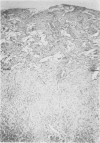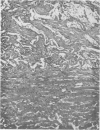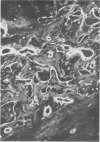Abstract
A bilayer artificial skin composed of a temporary Silastic epidermis and a porous collagen-chondroitn 6-sulfate fibrillar dermis, which is not removed, has been used to physiologically close up to 60% of the body surface following prompt excision of burn wounds in ten patients whose total burn size covered 50--95% body surface area (BSA). Following grafting, the dermal portion is populated with fibroblasts and vessels from the wound bed. The anatomic structure of the artificial dermis resembles normal dermis and serves as a template for the synthesis of new connective tissue and the formation of a "neodermis," while it is slowly biodegraded. This artificial skin has physiologically closed excised burn wounds for periods of time up to 46 days before the Silastic epidermis was removed. At the time of election when donor sites are ready for reharvesting, the Silastic epidermis is removed from the vascularized artificial dermis and replaced with 0.004 autoepidermal graft in sheet or meshed form. Clinical and histologic experience in a relatively short follow-up period (2--16 months) indicates that "neodermis" retains some of the anatomic characteristics and behavior of normal dermis, thus promising improvement in the functional and cosmetic results, as well as providing physiologic function as a skin substitute. The artificial skin is easily sterilized and stored at room temperature, capable of large scale production, and immediately available for grafting, indicating its potential for easy and relatively economic use in the burn patient.
Full text
PDF














Images in this article
Selected References
These references are in PubMed. This may not be the complete list of references from this article.
- Burke J. F., Bondoc C. C., Quinby W. C. Primary burn excision and immediate grafting: a method shortening illness. J Trauma. 1974 May;14(5):389–395. doi: 10.1097/00005373-197405000-00005. [DOI] [PubMed] [Google Scholar]
- Burke J. F., Quinby W. C., Bondoc C. C., Cosimi A. B., Russell P. S., Szyfelbein S. K. Immunosuppression and temporary skin transplantation in the treatment of massive third degree burns. Ann Surg. 1975 Sep;182(3):183–197. doi: 10.1097/00000658-197509000-00002. [DOI] [PMC free article] [PubMed] [Google Scholar]
- Burke J. F., Quinby W. C., Jr, Bondoc C. C. Primary excision and prompt grafting as routine therapy for the treatment of thermal burns in children. Surg Clin North Am. 1976 Apr;56(2):477–494. doi: 10.1016/s0039-6109(16)40890-x. [DOI] [PubMed] [Google Scholar]
- CHARDACK W. M., MARTIN M. M., JEWETT T. C., BOYER B. E. Synthetic substitutes for skin. Clinical experience with their use in the treatment of burns. Plast Reconstr Surg Transplant Bull. 1962 Nov;30:554–567. [PubMed] [Google Scholar]
- Chvapil M., Kronenthal L., Van Winkle W., Jr Medical and surgical applications of collagen. Int Rev Connect Tissue Res. 1973;6:1–61. doi: 10.1016/b978-0-12-363706-2.50007-6. [DOI] [PubMed] [Google Scholar]
- Dagalakis N., Flink J., Stasikelis P., Burke J. F., Yannas I. V. Design of an artificial skin. Part III. Control of pore structure. J Biomed Mater Res. 1980 Jul;14(4):511–528. doi: 10.1002/jbm.820140417. [DOI] [PubMed] [Google Scholar]
- Huang S. N., Minassian H., More J. D. Application of immunofluorescent staining on paraffin sections improved by trypsin digestion. Lab Invest. 1976 Oct;35(4):383–390. [PubMed] [Google Scholar]
- TANNER J. C., Jr, VANDEPUT J., OLLEY J. F. THE MESH SKIN GRAFT. Plast Reconstr Surg. 1964 Sep;34:287–292. [PubMed] [Google Scholar]
- Trelstad R. L., Lawley K. R. Isolation and initial characterization of human basement membrane collagens. Biochem Biophys Res Commun. 1976 May 23;76(2):376–384. doi: 10.1016/0006-291x(77)90735-5. [DOI] [PubMed] [Google Scholar]
- Woodroof E. A. Use of glutaraldehyde and formaldehyde to process tissue heart valves. J Bioeng. 1978 Apr;2(1-2):1–9. [PubMed] [Google Scholar]
- Yannas I. V., Burke J. F. Design of an artificial skin. I. Basic design principles. J Biomed Mater Res. 1980 Jan;14(1):65–81. doi: 10.1002/jbm.820140108. [DOI] [PubMed] [Google Scholar]
- Yannas I. V., Burke J. F., Gordon P. L., Huang C., Rubenstein R. H. Design of an artificial skin. II. Control of chemical composition. J Biomed Mater Res. 1980 Mar;14(2):107–132. doi: 10.1002/jbm.820140203. [DOI] [PubMed] [Google Scholar]









